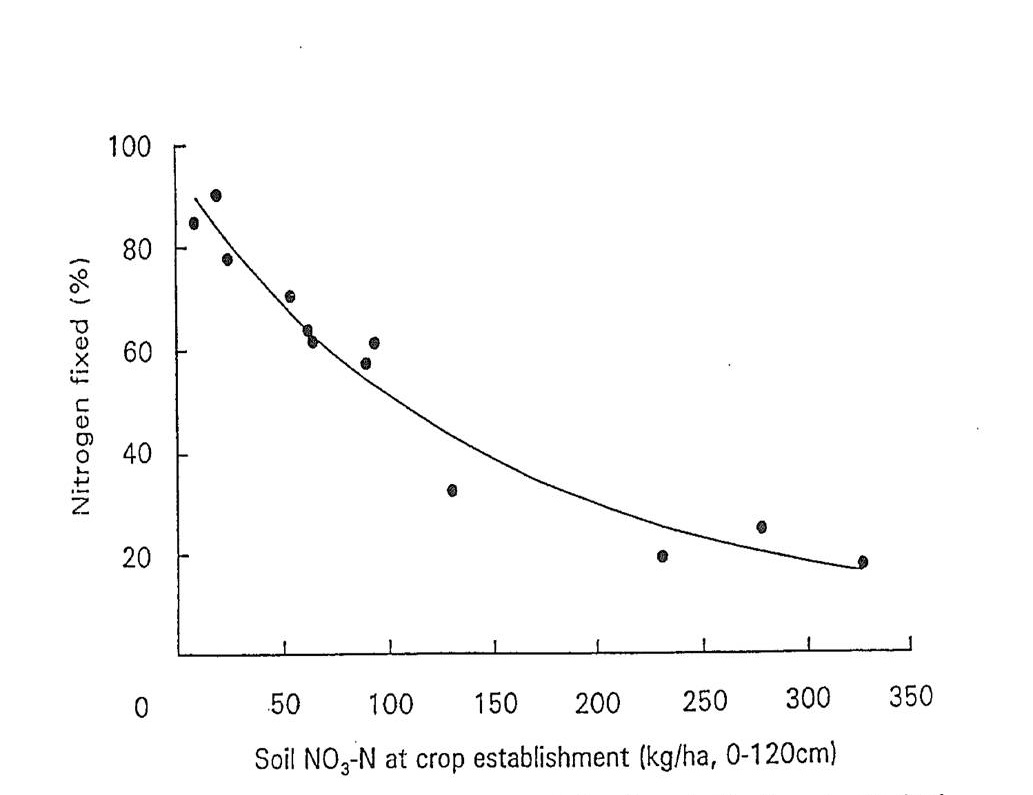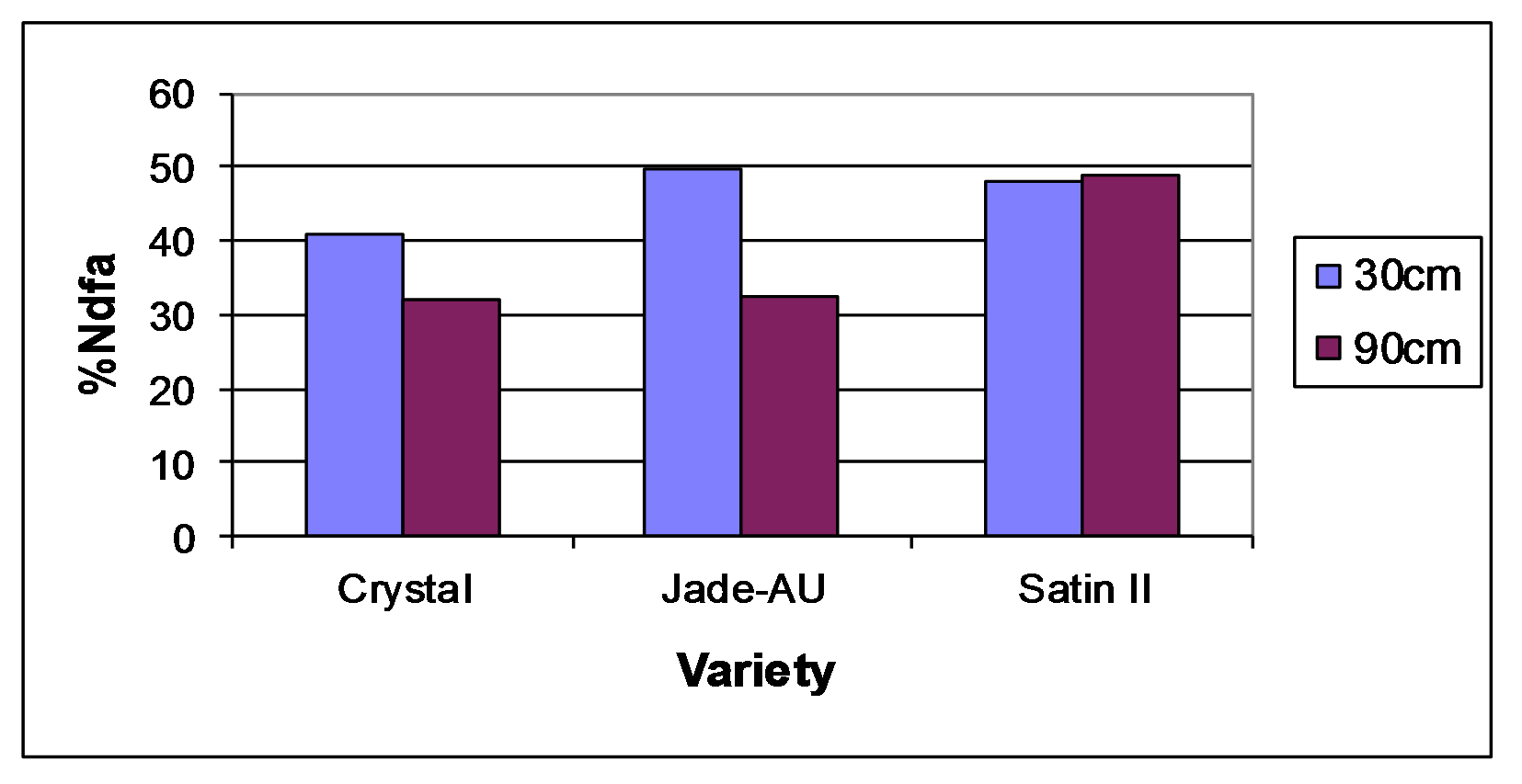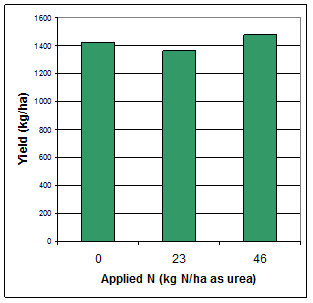Management impacts on N fixation of mungbeans and chickpeas
Author: Nikki Seymour, RCN Rachaputi and Richard Daniel | Date: 01 Jan 2001
 Varieties displaying this symbol beside them are protected under the Plant Breeders Rights Act 1994.
Varieties displaying this symbol beside them are protected under the Plant Breeders Rights Act 1994.
Authors
- Nikki Seymour, DAFF, Toowoomba
- RCN Rachaputi, QAAFI, Kingaroy
- Richard Daniel, Northern Grower Alliance
Take home messages
- Changes to agronomy can change N fixation in grain legumes
- In general, increasing row spacing may decrease amount of N fixed by legumes. N fixation in mungbean variety Satin 2
 however appears to compensate in N fixation for wider rows.
however appears to compensate in N fixation for wider rows. - Varieties can differ significantly in amount of N fixation and is related to biomass.
- High soil nitrate levels can reduce legume nodulation and N fixation by rhizobia. The addition of N fertiliser does not give any yield advantage in chickpeas or mungbeans and may reduce the amount of N available for the following crop.
Background
Chickpeas were the most widely grown legume crop in Australia in 2013 with about 85 per cent being grown in NSW and Queensland. Mungbeans in the years 2008 - 2010 were up to 70000 t average production after an average of just 40000 t in 2004 -2007, mainly through improved average yields. The vast majority are grown in the northern region of Australia.
The amount of N fixed by a legume increases as legume biomass increases but is reduced by high levels of soil nitrate. In general, legume reliance on N fixation is high when soil nitrate levels are below 50 kg N/ha in the top metre of soil. Above 200 kg N/ha, nitrogen fixation is generally close to zero. The fixed N is used for the growth of the legume itself (saving fertiliser application of the legume crop) as well as potentially leaving residual N for the following cereal or oilseed crop and providing a break from cereal stubble and soil-borne diseases.
Work by Doughton et al. (1993) clearly demonstrated the impact of increasing soil nitrate levels on N fixation of chickpeas (see Figure 1), with no yield advantage being gained by applying N. Moreover, chickpea provided a positive soil N balance when fixation rates were high and a negative balance at low fixation rates.
Figure 1. Per cent nitrogen fixed in chickpea (cv. Reselected Tyson) tops 130 days after planting for various levels of soil NO3-N at crop establishment. For fitted curve, Y = 7.05+88.45e-0.0070X, R2 = 0.95 (from Doughton et al. 1993).

Figure 1 text description
The following are approximates:
Nitrogen fixed results started at 90% and decreased in a continual curve to 20% when soil NO3-N at crop establishment was 325 kg/ha, 0-120cm).
Researchers in GRDC project DAQ00181 (Optimising N fixation in grain legumes – northern region) will be working closely with the new Pulse Agronomy projects in Qld and NSW as well as some Grower Solutions projects to identify agronomic practices to optimise legume growth and N fixation without compromising crop yield.
Row spacing, plant populations and variety
Field trials with summer (mungbean) and winter pulses (chickpea) were grown in 2013 in Queensland to examine the effects of varying agronomic factors on the growth, yield and N fixation of the pulses.
Mungbean
Over the 2012/13 summer, two mungbean trials were conducted at Taabinga and Redvale, near Kingaroy, Qld. Both trials consisted of the factorial combination of the following treatments:
2 row spacings (30 and 90 cm) x 3 plant populations (20, 30 and 40 plants/m2) x 3 varieties (Crystal , Satin 2
, Satin 2 and
and
Jade-AU ). Each had 3 replicates. Yields were not significantly different for any of the treatments at either trial but N fixation analyses showed that variety interacted with row spacing for the %Ndfa (per cent N in the plant shoots that is derived from the atmosphere not from soil nitrate supplies). Both Crystal and Jade-AU had much reduced N fixation as row spacing changed from 30 to 90 cm but Satin II fixed a similar high proportion of N (48 and 49%) for both row spacings (Figure 2).
). Each had 3 replicates. Yields were not significantly different for any of the treatments at either trial but N fixation analyses showed that variety interacted with row spacing for the %Ndfa (per cent N in the plant shoots that is derived from the atmosphere not from soil nitrate supplies). Both Crystal and Jade-AU had much reduced N fixation as row spacing changed from 30 to 90 cm but Satin II fixed a similar high proportion of N (48 and 49%) for both row spacings (Figure 2).
Figure 2. Percent N derived from the atmosphere for 3 mungbean varieties grown at two different row spacings

Figure 2 text description
The following are approximates:
Crystal shows 42% N at 30cm, and 32% at 90cm. Jade-AU shows 5% N at 30cm, and 33% at 90cm. Satin 2 shows 48% N at 30cm, and 49% at 90cm.
Chickpea
Two chickpea trials were conducted in the new GRDC Qld Pulse Agronomy project in the southern region (near Dalby and Goondiwindi). Each trial had the same design including 3 row spacings (0.25, 0.5 and 1.0 m) x 3 varieties
All 3 chickpea varieties at Dalby and Goondiwindi trials had significantly lower grain and total (grain +shoot) N uptake in kg/ha when grown at 1.0m row spacing. Also PBA HatTrick was significantly lower than Boundary
was significantly lower than Boundary and CICA0912 in N uptake at both sites. The impact of these management practices on N fixation and hence N uptake will be examined in detail following receipt of the 15N natural abundance data and will be discussed at the Update.
and CICA0912 in N uptake at both sites. The impact of these management practices on N fixation and hence N uptake will be examined in detail following receipt of the 15N natural abundance data and will be discussed at the Update.
N fertiliser addition
Chickpea
Trials conducted by Northern Grower Alliance in Qld and northern NSW across 6 sites in 2012 and 2 sites in 2013, showed no significant yield response in any individual chickpea trial to the addition of nitrogen fertiliser or the addition of rhizobia. In 2012, residual soil N at planting ranged from <12 to 117 kg N/ha (3 sites had 30 kg N/ha or less). Yields ranged from 1.1 to 2.0 t/ha (only one site >1.6 t/ha). The average yield response to applied N across all 6 sites is shown below in Figure 3. In this same set of trials, there was also no response to the addition of rhizobia inoculum applied as granules with the seed into the planting furrow.
In 2013, yields ranged from 0.75 to 1.3 t/ha with no response to N applied at 10 and 50 kg N/ha.
The lack of response to rhizobia inoculum overall is possibly due to adequate numbers of effective rhizobia already in the soil, however no assessments of nodulation or N fixation and residual soil N were conducted due to the lack of yield response. The seasons were hard and yields were obviously limited primarily by soil water.
Figure 3. Yield response of chickpea (variety HatTrick ) to applied N (no significant differences). Values are averages for 6 trials planted across Qld and northern NSW in 2012 each with 4 replicates.
) to applied N (no significant differences). Values are averages for 6 trials planted across Qld and northern NSW in 2012 each with 4 replicates.

Mungbean
Work in Central Queensland in 2010 also indicated that nodulation was suppressed by applications of urea at rates of 10 or more kg N/ha or Triple Super at 5 or 10 kg P/ha (Figure 4). Also, no yield advantage was gained by the addition of fertiliser N (Figure 5). (Seymour et al. 2010). Pre-plant soil nitrate levels at this site started at about 80kg N/ha in the top 1m and were increased from there with applied fertilisers. There was also a history of mungbeans at this site contributing to the nodulation of the uninoculated treatments. Despite this, there was a significant yield response to inoculation.
Figure 4. Impact on nodulation of mungbean cv. Crystal from rhizobial inoculation and preplant fertiliser applications.
from rhizobial inoculation and preplant fertiliser applications.

Figure 4 text description
The following are approximates:
- Seed not inoculated was 0.035g/plant
- Control - seed inoculated was 0.0375g/plant
- Triple Super 5 2.5kgP/ha was 0.325g/plant
- Triple Super 5 kgP/ha was 0.015g/plant
- Triple Super 5 10 kgP/ha was 0.02g/plant
- Urea 10 kgN/ha was 0.013g/plant
- Urea 20 kgN/ha was 0.0175g/plant
- Urea 40 kgN/ha was 0.0175g/plant
- Granulock Supreme Z 5 kgP/ha was 0.024g/plant.
Figure 5. Response of mungbean cv. Crystal to inoculation and preplant fertiliser applications.
to inoculation and preplant fertiliser applications.

Figure 5 text description
The following are approximates:
- Seed not inoculated was 950kg/ha
- Control - seed inoculated was 1100kg/ha
- Triple Super 5 2.5kgP/ha was 1100kg/ha
- Triple Super 5 kgP/ha was 1000kg/ha
- Triple Super 5 10 kgP/ha was 950kg/ha
- Urea 10 kgN/ha was 1100kg/ha
- Urea 20 kgN/ha was 1100kg/ha
- Urea 40 kgN/ha was 1050kg/ha
- Granulock Supreme Z 5 kgP/ha was 1050kg/ha.
Acknowledgements
Many thanks for support from Howard Cox, Stephen Krosch, James McLean, Kerry McKenzie and NGA researchers.
References
Seymour NP, Conway M, Erbacher A, Aisthorpe D and Quinlivan M (2011). Nitrogen fertiliser reduces nodulation of mungbean but gives no yield advantage in Central Queensland. 17th International Congress on Nitrogen Fixation. Fremantle, WA. 27 November -1 December 2011
Doughton JA, Vallis I, Saffigna PG (1993) Nitrogen fixation in Chickpea. I. Influence of Prior Cropping or Fallow, Nitrogen Fertilizer and Tillage. Australian Journal of Agricultural Research 44: 1403 – 13.
Recommended reading
‘Inoculating legumes: A practical guide.’ Ground Cover Direct
www.grdc.com.au/GRC-Booklet-InoculatingLegumes
'Managing legume and fertiliser N for northern grains cropping.’ Ground Cover Direct
www.grdc.com.au/GRDC-Booklet-ManagingFertiliserN
Contact details
Nikki Seymour
Dept Agriculture, Fisheries and Forestry Queensland
Ph: 07 4639 8837 07 4639 8837
07 4639 8837
Fx: 07 4639 8800
Email: nikki.seymour@daff.qld.gov.au
GRDC Project Code: DAQ00181,
Was this page helpful?
YOUR FEEDBACK
